Moles appear on many people's bodies, and in the vast majority of cases they are benign formations that do not require medical supervision. But sometimes they bother the owner, and he has to go to a specialist. Which doctor to see is an open question for many.
Which doctor should I go to?
The first specialist to visit should be a therapist. Having a wide range of diagnostics and treatment of diseases, he will examine the site to determine the presence or absence of pathology. If the formation seems atypical to the therapist, he will refer you to a dermatologist. This doctor conducts a thorough visual examination, if necessary, offering dermatoscopy, the results of which will make it clear whether to remove this mole or not to touch it. By studying the inner layers of the skin, the procedure will make it clear whether there is a danger.
If the dermatologist gives an order to get rid of the nevus, the further path lies with a surgeon and oncologist. Doctors will carefully study the results of dermatoscopy, and then offer several removal techniques to choose from. You can go the surgical route and cut it out or resort to burning. The latter includes removal using liquid nitrogen, laser or electricity. It will be necessary to take tissue samples for histological examination - biopsy.
Signs of malignancy
Only some types of pigmented nevi are classified as unsafe formations. A normal benign spot remains the same throughout life, and if you notice changes, then you should check everything and see a doctor so as not to miss the onset of cancer.
- Color change. The most frightening sign is a dull or brighter shade. Occasionally, moles can become completely black, but even the slightest change in color is a reason to see a specialist. Also an alarming symptom is uneven coloring, the appearance of dots or nodules, and the edges of the birthmark painted black.
- Asymmetry. Initially, all people have moles of the correct shape, which does not change over the years. If, when drawing an imaginary line without bends through the center of the nevus, you do not see two identical halves, this indicates deformation, which may be a sign of oncology.
- Change of size. First of all, this concerns an increase, but a sudden decrease should also alert you. Do not delay visiting a doctor if it is swollen, hot, or hard.
- Lack of clarity. Healthy moles have defined boundaries, and if the area blurs, sound the alarm. Another reason to visit a doctor is a red halo around you.
- Discomfort. Itching, burning, tingling - any of these signs indicate degeneration of the formation. Consult a doctor as soon as possible to prevent cracks and ulcers on the skin from appearing in its place. Bleeding requires a thorough examination to check all possible options.
Not all people have moles, and even more so, malignant ones. There are several factors influencing the degeneration of benign formations:
- ultraviolet. Exposure to a germicidal lamp from a solarium or large amounts of sunlight negatively affects the skin, creating a risk of melanoma;
- a large number of nevi. They can provoke the degeneration of one or more into malignant ones when exposed to ultraviolet radiation;
- freckles. People who become covered with red spots from one ray of sun should be especially careful;
- old age. Older people are more exposed to environmental influences than others, and the risk of melanoma increases every year;
- bright skin. People with dark skin have less developed pigmentation, so their risk of degeneration is much lower than that of white-skinned people;
- heredity. If your relatives have had cases that required medical supervision, inform a specialist about this.
The first step in all studies is to ask about similar conditions in the past or in relatives. If there has been degeneration of nevi in loved ones, consult a doctor, he will prescribe a gene test that can identify a predisposition to cancer. If a case of a change in formation occurred in your case, then this may be a relapse, and then a thorough examination of the body will be required.
You can conduct an external inspection yourself or seek help from a specialist. The most likely places for melanoma to appear are the legs and thighs. You need to carefully examine and show the doctor the area under the knees, as well as those areas of the body that are not visible to you in the mirror and during water procedures. Treatment for a degenerated mole depends on where it is found, but most often it is a simple surgical intervention.
If you discovered a mole yourself, it is very disturbing and has signs of developing melanoma, then you should go to the clinic and donate blood to identify a tumor marker typical for skin cancer. For a more accurate study, a biopsy of the affected tissue and molecular diagnostics are performed, which allow us to accurately understand the nature of the nevus.
Non-invasive diagnostic methods also include radioisotope body scanning and confocal microscopy. And if the first involves scanning a mole, the second allows you to thoroughly check all layers of skin in the affected area, observing the cells through a microscope. These techniques, although they have different ways of obtaining information, are both new generation biopsies that do not involve tissue.
Moles are congenital or acquired formations on the skin. In medicine they are called nevi. If you notice their presence, there is no need to sound the alarm. It is enough just to go to a medical facility to check moles once a year. The specialist will be able to notice any changes and diagnose the disease, if any. How are moles checked? How is cancer diagnosed? We will talk about this in our article.
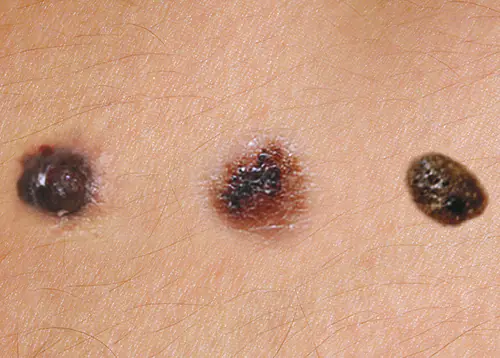
Causes for concern
Every person has moles on their body, and they can be large or small, flat or convex, smooth or grainy, dark or light. It is not necessary to examine every spot very carefully and scrupulously, but you need to monitor whether the nevus changes over time. Particular attention is paid to those spots that are located in the groin area and under the chest.
But why monitor the condition of your mole? The fact is that even the smallest spots on the body under the influence of ultraviolet rays or other factors can develop into a malignant tumor. That is why those people who have lighter skin and a lot of nevi on their bodies should avoid direct sunlight, as well as tanning in a solarium. In addition, a simple injury to a birthmark can lead to serious consequences. Before answering the question of how moles are checked for a malignant form, it is necessary to understand their main varieties.
Types of birthmarks
The main types of moles include:
- Vascular. They appear due to too rapid growth of skin capillaries.
- Pigmented. They appear due to the fact that the body produces too much melanin pigment.
Another classification:
- Congenital. The baby is born with them.
- Acquired spots, which depend on the patient’s genetics, skin type, and sun exposure.
In addition, there are nevi, the entire plane of which is located on the skin, and hanging ones, that is, on a stalk.
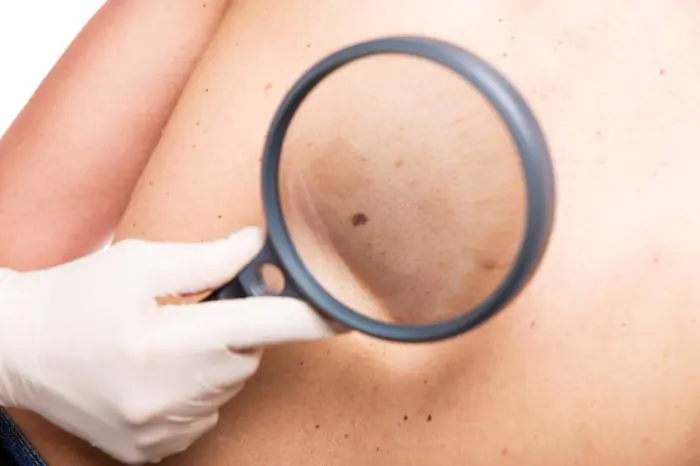
How to check moles
There is a simple, very interesting method that allows you to check your nevus for a malignant form. You just need to remember one word "chord", in which each letter has its own meaning.
- "A" stands for asymmetry. If your nevus is uneven and asymmetrical, then this may be a sign of a malignant form of formation.
- "K" means edge. If a birthmark has torn and uneven borders, then this is also a sign of malignancy.
- Another "K" is for the bleeding of a mole.
- “O” in this case implies the color of the formation. If the nevus changes shade, or spots or stripes of different colors have formed on it, then this is a cause for concern.
- "P" is the size of the mole. Large tumors have more prerequisites for malignant degeneration.
- "D" implies dynamics. If the spot has increased in size, cracks or crusts have appeared, you should immediately consult a doctor.
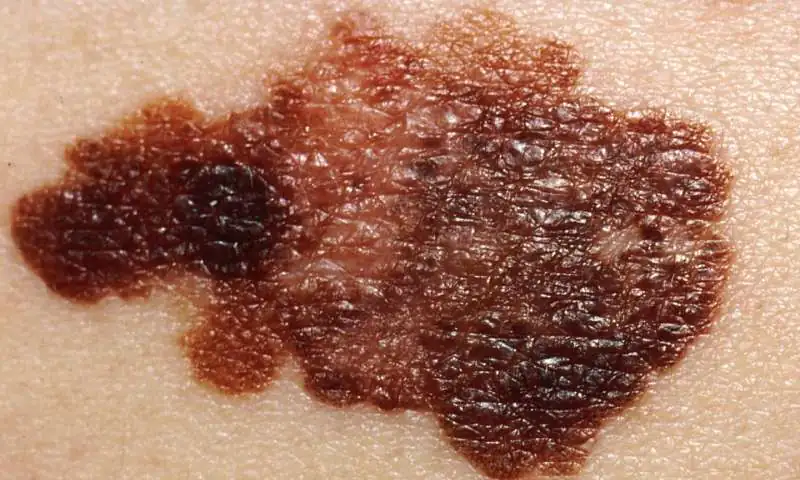
Alarming symptoms
We continue to look at how moles are checked for a malignant form. If the spot begins to degenerate, change color, become lighter or darker, then this is a very alarming symptom. In addition, if a mole has increased by 5 mm in diameter over a couple of months, this indicates a malignant transformation.
If severe pain occurs during a birthmark injury, this is also a serious symptom. Despite all the dangerous symptoms described above, it should be noted that only a qualified specialist can check a mole for cancer. Under no circumstances should you self-diagnose at home or carry out self-treatment.
Precautionary measures
In case of injury to the formation, the doctor may prescribe the patient to remove the mole. This can be done using a laser, liquid nitrogen, or simple surgery. As a rule, after such manipulation the material is sent to the laboratory for histological examination. This is the most accurate diagnostic method.
Where to check a mole for cancer? Only in the hospital. As a rule, these are oncology centers where the birthmark was removed. It should be said that histology can only be carried out if the doctor has biological material. When a mole is burned out with a laser or liquid nitrogen, as a rule, no mole remains.
You should know that the development of skin cancer can be prevented by avoiding direct sunlight. If you go to the beach, it is best to do this in the morning, as well as in the evening after 4 o’clock. It is necessary to use sunscreen. Also bring hats and sunglasses. Whenever possible, you should wear cotton clothing in summer. Despite the fact that the heredity factor in this case is of great importance, the likelihood of developing cancer can be reduced if you follow these simple tips.
Diagnostics
If you want to check your skin for cancer, you need to perform a dermatoscopy. Which doctor checks moles? As a rule, this is done by a dermatologist. During diagnosis, he examines the skin through a special magnifying glass, after which he records the dimensions and changes. If this examination is not enough, the specialist will prescribe tests that the patient must undergo. If deviations from the norm are detected, the tumors are removed simply surgically or using cryotherapy.
Many people are also interested in where to get moles checked. Currently, similar procedures are carried out in almost all public hospitals.
Dermatoscopy is performed if there are several moles on the body located on light skin. This procedure is also carried out if the patient has damaged his tumor, if the number of growths has begun to increase sharply, or if unpleasant sensations have appeared in the place where the nevus is located.
Other research methods
There are many hospitals that check moles. In Moscow, as well as in other large cities of Russia, there are a large number of paid clinics dealing with oncological issues. If, after visiting such an institution, a specialist diagnoses a malignant disease, then it is necessary to identify its form, as well as prevent rapid spread. To do this, a chest x-ray is taken, liver function is checked, and a biochemical blood test is taken.
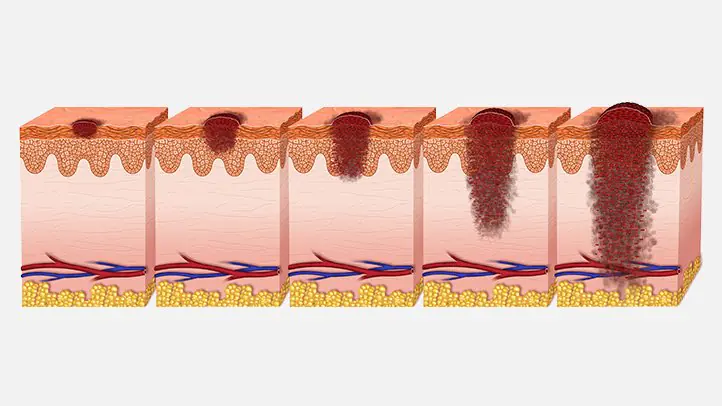
Self-examination - is it possible or not?
We have figured out where to check a mole for a child and an adult. However, you should pay attention to the fact that the procedure can be carried out at home. However, after it, you still need to go and have the mole checked by a dermatologist in order to be sure of the presence or absence of a malignant form.
A birthmark that can degenerate into a cancerous formation is detected by the signs that were described above. You can monitor its dynamics on your own, but you cannot treat it at home.
Which specialists examine
If symptoms of a malignant mole appear or if melanoma is suspected, you should seek help from a specialist. We answered above that most often people turn to a dermatologist with this problem. If your clinic has a dermato-oncologist, it is best to contact him. This is a doctor who specializes specifically in skin cancer. In most cases, such specialists are seen in large cancer centers. Unfortunately, they are not available in all localities. If you live in a metropolis, then you can check a mole for your child or yourself with a dermato-oncologist.
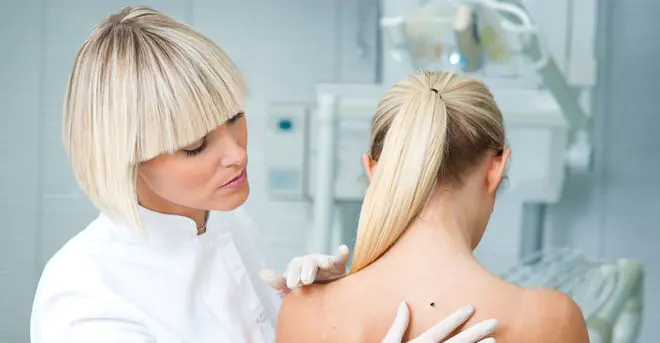
Some clinics or specialized institutions have general oncologists. Most often, such hospitals also have their own histological laboratories, so the biomaterial will be examined directly on the spot.
As for dermatologists, they do not specialize in melanoma, but they know everything about various skin diseases. This doctor is able to accurately distinguish a harmless nevus from a malignant melanoma, and then give the patient further recommendations.
Addresses of clinics in the capital
Where to check moles in Moscow? Best clinics:
- Russian Oncology Research Center named after. N.N. Blokhina: Kashirskoe highway, 23.
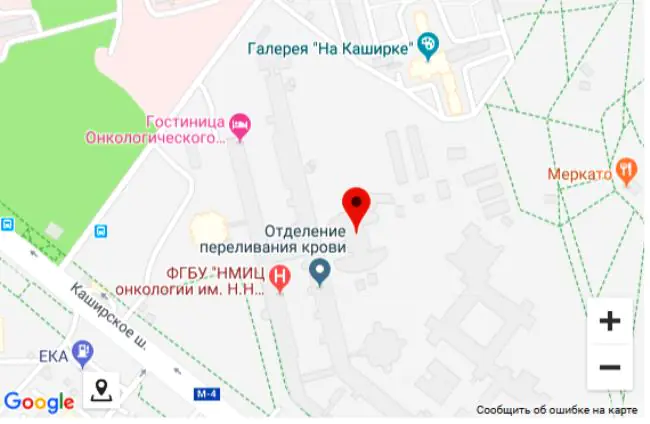
- Yusupov Hospital: Nagornaya street, 17, bldg. 6.
- European Clinic: Dukhovskoy Lane, 22 B.
- Clinic of Oncoimmunology and Cytokine Therapy: st. Stroiteley, 7, bldg. 1.
- Moscow Scientific Research Oncological Institute (MNIOI) named after. P.A. Herzen: 2nd Botkinsky proezd, 3.
Risk factors
There are several factors that influence the increase in the likelihood of a harmless mole degenerating into melanoma. These include:
- Too pale skin.
- The areas of the skin where the mole is located are not protected from exposure to ultraviolet radiation (hands, face).
- Relatives have or have had melanoma.
- Too many moles on the patient’s body.
- Elderly age.
- Male gender.
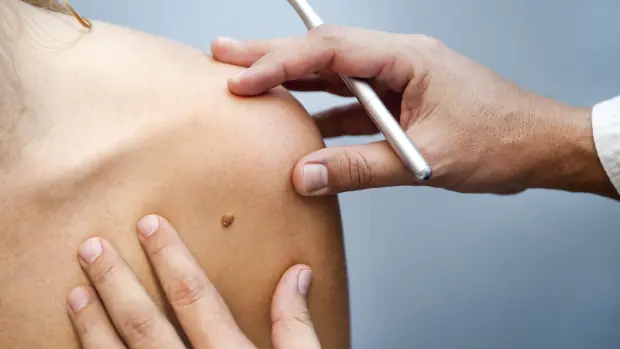
Possible consequences
If you do not consult a doctor when the first signs of malignant melanoma appear, this can provoke very unpleasant consequences, even death. Some people consider skin cancer not very dangerous, since they are sure that it is never too late to cut out melanoma. However, this disease is very insidious. It almost always metastasizes, meaning cancer can start anywhere in the body. This is precisely why melanomas are dangerous.
If you want to get reliable results, then you must also undergo examination by an immunologist, endocrinologist and other specialized specialists. Damage to the skin may indicate the development of diabetes. If the tumor is located near the eye, then in this case an ophthalmologist will help you. An immunologist determines how a person’s immune system works. If it is strong enough, it can inhibit the growth of cancer cells for some time.
To avoid various kinds of complications, it is necessary to carry out prevention. To do this, experts recommend removing moles that rise above the skin, as well as those that change color or become damaged.
Patient opinions
Feedback from patients suggests that they can be left alone if they do not change over time and do not cause any problems. Both doctors and patients advise removing formations if a mole suddenly begins to change its shape, color, or size. You also need to get rid of pigmented formations that are located in places on the body where they are constantly exposed to injury or create psychological discomfort.
In beauty salons, nevi are simply removed, but are not checked for histology. To conduct such a study, you need to contact a medical institution. In reviews, people write that the mole removal procedure is absolutely painless.
Medical expert article
Moles are congenital marks on the skin that can change throughout life. Let's consider where to check moles and how to identify the symptoms of their pathological degeneration.
Birthmarks are areas of skin with special pigmentation. If there are a lot of them on the body, then this can cause discomfort and cause a number of concerns. Skin bumps and brown spots can develop into melanomas and other pathologies that require timely diagnosis and treatment. Sometimes it is enough to overdo it with tanning, both solar and artificial, in order to get serious problems. Ultraviolet rays have an aggressive effect on cells and create favorable conditions for the development of oncology. Birthmarks in the groin area and under the breasts in women deserve special attention.
Main types of birthmarks:
- Congenital - appear at birth or in the first months of life. They are rare and very often degenerate into melanoma.
- Acquired - their number depends on genetic factors, sun exposure and skin type. The more such pigment spots, the higher the risk of cancer.
- Atypical - have uneven contours, large size and several shades that are very different from healthy skin. Their presence may portend malignant degeneration.
It is recommended to check pigmented growths for various pathologies once a year. Moles can be checked by a dermatologist at a local clinic or specialized medical center. The doctor will examine the birthmarks and determine their condition. If necessary, he will recommend removal or prescribe additional diagnostics.
Which doctor can have moles checked?
If there are many pigment spots of different sizes and shapes on the skin, then this is a cause for concern. Which doctor can check moles? This is the question that arises among people with similar skin features. First of all, you need to see a dermatologist. The doctor conducts a visual examination and, if necessary, gives a referral to a dispensary or oncology center to clarify the diagnosis.
You can immediately contact a dermatologist-oncologist who deals with skin cancer. Using dermatoxop, the doctor will examine suspicious nevi, scrape them, and check the cells for malignancy. If there are malignant moles, they are removed; surgery is indicated if malignant degeneration is suspected. The procedure must be performed in a specialized medical facility, and not in a beauty salon that also offers mole removal.
Dangerous nevi are removed using radiation or surgical methods. Laser operations are not recommended, as they are characterized by frequent relapses of tumors. It is strictly contraindicated to remove moles yourself using traditional medicine methods, as this will only speed up the process of degeneration and can cause skin cancer.
Where to check a mole for cancer?
At the slightest suspicion of malignant degeneration of a nevus, you must seek medical help. Elementary care will allow you to identify pathology in time and begin its treatment. Where to check a mole for cancer is a pressing question when examining atypical skin pigmentation.
The test is carried out using dermatoscopy. Using a special instrument that looks like a magnifying glass with high magnification, the doctor examines suspicious areas of the skin. The examination takes place in the office of a dermatologist-oncologist. If necessary, in addition to a visual examination, the doctor prescribes additional tests.
There is a method by which you can independently recognize the degeneration of a nevus. There are five signs, conventionally called ABCDE or ACORD, let’s look at them:
- Asymmetry - carefully examine the mole and, if necessary, photograph it. Determine its center and draw a line; if both sides of the pigmented neoplasm are symmetrical, then everything is in order. If there are protrusions and uneven growths, then medical diagnosis is necessary.
- Contour – a healthy nevus has a smooth contour with rounded edges. If it has an uneven perimeter or uneven coloring, then this indicates pathology.
- Color – a normal pigment spot has a uniform color of brown or dark brown. If there are sharp color transitions from light to dark, you should consult a doctor.
- Size – pay attention to all birthmarks that are on the body. If their diameter is more than 0.6 cm or there are areas with a large number of small moles, then there is a high probability of their degeneration.
- Dynamics - this sign implies changes in color, size, texture, the appearance of blood or hairs. If for a long time the pigmented neoplasm has remained unchanged, but its size or other signs suddenly change, then this is a reason to consult a dermatologist.
Where to check moles in Moscow?
If you have several nevi that are causing concern, then medical attention is needed. To do this, you should go to the clinic and take a referral to a dermatologist or dermatologist-oncologist, who will conduct a comprehensive examination of the tumor.
Let's look at where to check moles in Moscow:
- Dermatology Clinic – Dmitrovskoye Shosse, 27, building 1, 20th floor. Phone: 8 (495) 638-58-58
- Oncology Center - Kashirskoye Highway, 23, zone B-1, Department of Oncology. Phone: 77-26-387.
- Institute of Beauty - Olkhovskaya, 27. Phone: +7 (499) 267-90-41, +7 (499) 267-77-44.
- Treatment and diagnostic medical center "Kutuzovsky" - st. Davydkovskaya, 5. Phone: +7 (499) 372-15-55.
- Medical Laboratory “United Medicine” – Likhov Lane, 3. Phone: +7 (495) 740-05-87, +7 (495) 740-05-87.
Where to check moles in St. Petersburg?
Atypical pigmentation on the skin requires medical attention. If you notice that moles have changed color or increased in size, you should consult a dermatologist.
Where to check moles in St. Petersburg:
- Laser Medicine Center “Lazermed” – st. Dumskaya 5/22. Phone: 8 (812) 571-52-69, 8 (812) 571-46-12.
- Center "Altermed Dermatology" - Pyatiletok Avenue, 6, building 1. Phone: (812) 426-12-19.
- Polyclinic "ABIA" - Primorsky district, Korolev Avenue, 48, building 7. Phone: +7 (812) 306-11-11.
- Medical Center “Longevity” – st. Bronnitskaya, 15. Phone: +7 (812) 306-11-11.
- Multidisciplinary medical clinic "Med-Art" - st. Shavrova, 13/1. Phone: +7 (812) 431-28-28.
Where to check a mole in Kyiv?
About 1% of skin cancers occur from the degeneration of nevi. Prolonged exposure to the sun, artificial tanning, and congenital skin pathologies are factors that increase the risk of cancer.
Let's consider popular clinics and medical centers where to check a mole in Kyiv:
- Institute of Dermocosmetology Doctor Bogomolets - Taras Shevchenko Boulevard, 17. Phone: +38(044) 235-00-08
- Ukrainian Research Institute of Oncology and Radiology – st. Lomonosova, 33/43. Phone: (044) 263-53-97.
- Oncology center - st. Verkhovinnaya, 69. Phone: +38 (044) 424-68-18.
- Clinic Virtus – st. Konstantinovskaya, 57. Phone: +38 (044) 332 44 00.
- Capital Clinic – st. Lepse, 4a. Phone: +38 (044) 454-04-44.
Where to check a mole in Kharkov?
A mole is not only a cute natural decoration of the skin, but also a hidden danger. Without proper skin care, pigmented neoplasms can transform into dangerous tumors.
Clinics where you can check a mole in Kharkov:
- Medical center "ON Clinic" - st. Sumskaya, 13. Phone: +380 (57) 719-77-77.
- Clinic “Mavrovaya Dobrinka” – st. Potrebni, 6, +38 (057) 780-51-58.
- Clinic "Vitrus" - st. Chernyshevsky, 30. Phone: +38 (095) 139-60-30.
- Kharkov city dermatovenerological dispensary No. 5 – st. Chernyshevskaya, 27. Phone: +38 (057) 725-06-59.
- Center for Dermatology and Medical Cosmetology “Sana” – st. Pushkinskaya, 43. Phone: +38 (057) 706-30-30.
Where can I get my moles checked for free?
To prevent malignant degeneration of moles, it is necessary to undergo an examination by a dermatologist once a year. If the examination takes place at a local clinic, it is free. When visiting private medical centers and clinics, you will have to pay for a consultation with a dermatologist and diagnostic procedures.
Let's look at where you can check moles for free:
- Russian Oncology Research Center named after. Blokhina N.N. – Kashirskoe highway, 23. Phone: +7 (499) 324-19-19, +7 (499) 324-42-76.
- Department of Coloproctology and Endoscopic Surgery – st. Pogodinskaya, 1. Phone: +7 (499) 686-00-16.
- Dermatovenerologic dispensary – Sergiev Posad, st. Mitkina, 37. Phone: +7 (496) 540-90-99.
- Dermatovenerological dispensary – Zheleznodorozhny Avenue, 28. Phone: +7 (812) 560-14-70.
- Regional Dermatovenerological Dispensary - Rizhsky Avenue, 43. Phone: +7 (812) 251-15-26.
- City Clinical Oncology Dispensary - Veteranov Avenue, 56. Phone: +7 (812) 756-98-51.
- NMU, Department of Skin and Venereal Diseases - st. Shelkovichnaya, 39/1. Phone: +38 (044) 234-62-75.
- City Dermatovenerological Dispensary – st. Saksaganskogo, 72. Phone: +38 (044) 288-11-86.
- Medical Center “Layan Winner” – st. Proriznaya, 25a.
- Institute of Dermocosmetology Doctor Bogomolets - Taras Shevchenko Boulevard, 17. Phone: +38(044) 235-00-08
- Regional Dermatovenerologic Dispensary – st. Karl Marx, 17. Phone: +38 (0572) 712-33-96.
- Kharkov city dermatovenerological dispensary No. 5 – st. Chernyshevskaya, 27. Phone: +38 (057) 725-06-59.
- Kharkov Regional Clinical Oncological Center – st. Lesoparkovaya, 4. Phone: +380 (57) 315-01-00.
To hospitals and centers where you can check moles free of charge, you must obtain a referral from a local dermatologist and make an appointment with a doctor in advance. Regular medical diagnostics and independent examinations of the skin can identify and prevent pathological degeneration of moles.



